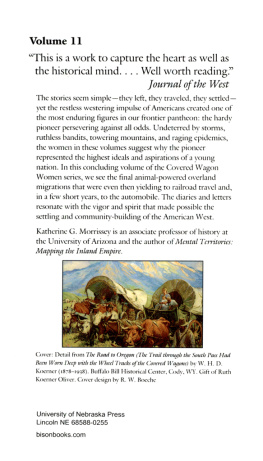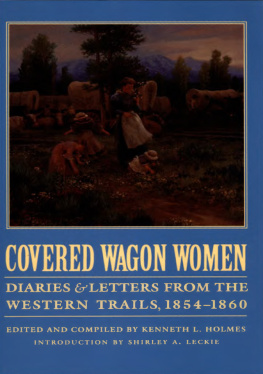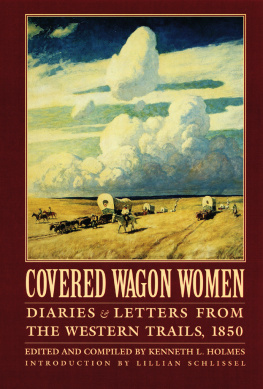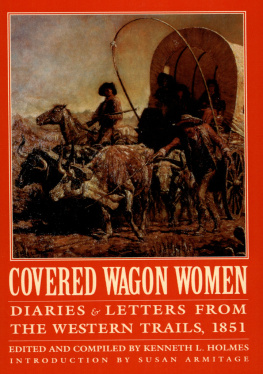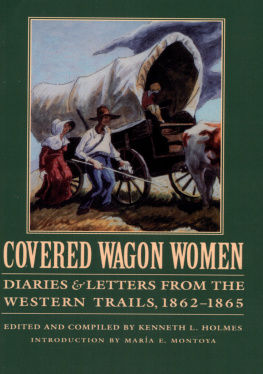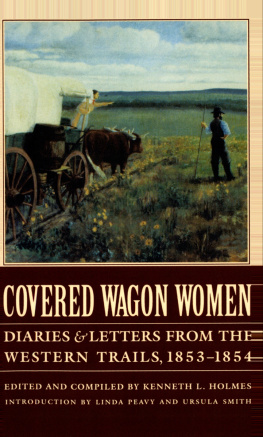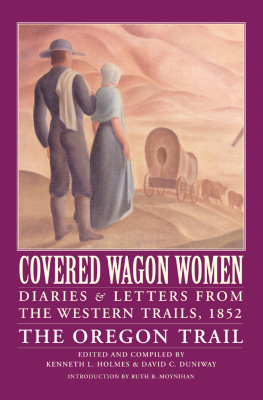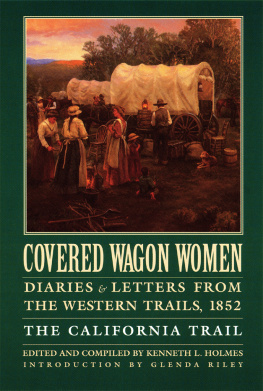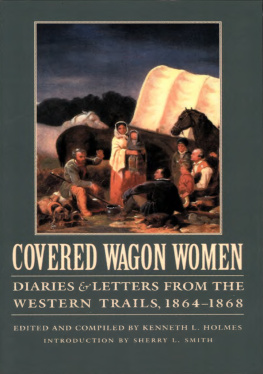


1993 by Kenneth L. Holmes. Reprinted by arrangement with the Arthur H. Clark Company. Introduction to the Bison Books Edition 2000 by the University of Nebraska Press Emigrant Routes to the West map 2000 by the University of Nebraska Press
All rights reserved
Library of Congress Cataloging-in-Publication Data
The Library of Congress has cataloged Vol. 1 as:
Covered wagon women: diaries & letters from the western trails, 18401849 / edited and compiled by Kenneth L. Holmes; introduction to the Bison Books edition by Anne M. Butler.
p. cm.
Originally published: Glendale, Calif: A. H. Clark Co., 1983.
Reprinted from volume one of the original eleven-volume edition
T.p. verso.
Volume 1.
Includes index.
ISBN -10: 0-8032-7277-4 (pa: alk. paper)
ISBN-13: 978-0-8032-7481-5 (electronic: e-pub)
ISBN-13: 978-0-8032-7482-2 (electronic: mobi)
1. Women pioneersWest(U.S.)Biography. 2. West(U.S.)History. 3. West (U.S.)Biography. 4. Overland journeys to the Pacific. 5. Frontier and pioneer life West (U.S.) I. Holmes, Kenneth L.
F591.C79 1996 978-dc20 95-21200 CIP
Volume 2 introduction by Lillian Schlissel
ISBN 0-8032-7274-X (pa: alk. paper)
Volume 3 introduction by Susan Armitage
ISBN 0-8032-7287-1 (pa: alk. paper)
Volume 4 introduction by Glenda Riley
ISBN 0-8032-7291-X (pa: alk. paper)
Volume 5 introduction by Ruth B. Moynihan
ISBN 0-8032-7294-4 (pa: alk. paper)
Volume 6 introduction by Linda Peavy and Ursula Smith
ISBN 0-8032-7295-2 (pa: alk. paper)
Volume 7 introduction by Shirley A. Leckie
ISBN 0-8032-7296-0 (pa: alk. paper)
Volume 8 introduction by Maria E. Montoya
ISBN 0-8032-7297-9 (pa: alk. paper)
Volume 9 introduction by Sherry L. Smith
ISBN 0-8032-7298-7 (pa: alk. paper)
Volume 10 introduction by Elliott West
ISBN 0-8032-7299-5 (pa: alk. paper)
Volume 11 introduction by Katherine G. Morrissey
ISBN 0-8032-7300-2 (pa: alk. paper)
The pagination has not been changed and no material has been omitted in this Bison Books edition.
The publisher does not have any control over and does not assume any responsibility for author or third-party websites or their content .
Illustrations
Introduction to the Bison Books Edition
Katherine G. Morrissey
To stop by a drugstore to pick up peppermint lozenges is a commonplace errandas familiar to readers today perhaps as it was to a woman named Huldah, who bought some of the flavored drops more than a century ago. Such an event seems hardly worth mentioning. But a Mrs. Hampton includes the task in her 1888 diary. What makes this errand worthy of note and somewhat incongruous is that a covered wagon woman purchased the lozenges while traveling overland to Oregon. Part of a ten-person family caravan headed from south-central Kansas to Portland, Oregon, Mrs. Hampton, who never indicates her first name, includes other curious details in her diary. In Cheyenne, Wyoming, for example, she sends out the groups dirty clothes to a laundry. And after the family members reach Fossil, Wyoming, and encounter snow, they decide to take the passenger train, loading horses, wagons everything into a freight car (162). Whatever your expectations of the activities of female overland travelers, I suspect that picking up peppermint lozenges and availing oneself of laundry and train services were not among them.
You will encounter a number of such momentswhere expectations are mismatched with experiencesin this engaging collection of late nineteenth-century and turn-of-the-century diaries, the eleventh and final volume of the chronologically arranged Covered Wagon Women series. Unlike many of the earlier volumes, which include accounts of trips that took place within a single calendar year or a brief span of years, this set of diaries ranges over a twenty-five-year period, from 1879 to 1903. The time frame helps explain some of the seeming oddities. The West of the 1880s and 1890s differed in many ways from that of the 1840s and 1850s. By the time these diary writers undertook their excursions, the region through which they passed had undergone a dramatic transformation.
The presence of towns with handy drugstores and laundries was only one manifestation of larger economic and political developments in the late nineteenth-century West. As you read through the diaries you will come across other such markers of change: train sounds, irrigation ditches, telegraph news, and Indian reservation schoolchildren, to name a few. The diary of twenty-year-old Viola Springer, who is making her second trip across, offers a guide to new developments; she frequently records comparative remarks. Returning west in 1885, the Springers retrace parts of the trail they had taken six years earlier. Springer finds the familiarity of campsites welcome, but there are also noteworthy differences. One site where freighters used to camp is no longer in use because freight teams have been replaced by the Oregon Short Line, a railroad line from Granger, Wyoming, to Portland built by the Union Pacific in the early 1880s (120). New railroad construction also affects their trip in more direct ways. When their party reaches the Nebraska border, for example, they meet a railroad labor agent who offers them free train transportation in exchange for some work at a Kearney track construction site. So they hop on the iron horse to speed their way across at least a third of the state.
Although only the Springer and Hampton parties combine train and trail travel, railroads had an impact on many of the later overland trips included in this volume. Along with numerous local and branch lines, transcontinental railroads snaked across the country, with the Northern Pacific and Great Northern joining the Union Pacific by the late 1880s. Customary trail routes sometimes paralleled train tracks, allowing brief waving exchanges between Pullman passengers and wagon women. If we wasnt in sight when the cars went along we could hear them, notes Springer (94). For homesick and discouraged party members, such as Violas sister-in-law, Martha Springer, the cars held the possibility of an escape route back home. Other individuals, such as John Ball, took advantage of the transportation to take side trips to visit relatives, rejoining the caravan farther down the trail. The freight trains brought supplies to the towns through which the travelers passed, linking them directly to the nations market economy. Mrs. Hampton and her companions did a lot of shopping on the trail, buying provisions from merchants, farmers, and fellow travelers. Their purchases included basics, such as flour, butter, milk and feed, but also merchant goods, such as gingham and a sheet-iron stove. While we might find the ready availability of stores and supplies surprising, it was not so odd to the travelers. In fact, Mrs. Hampton considers the absence of stores in some sections of the country remarkable.
Despite the influence of the railroad, there are days when the landscape of the trail as recorded in these diaries seems indistinguishable from that faced by westering women twenty-five years earlier. Readers of the previous volumes in this series will find familiar landmarks, activities, and concerns. Sod houses and prairie dogs still evoke interest along the Platte River road. Sandy ravines impede wagons progress across the Snake River plain. Reports on illnesses, discussions of personalities, and constant references to weather conditions, whether sunshine or clouds, thunderstorms or dust storms, fill the pages. We are wet and sassy and nasty is Ada Colvins description one day (24). It seems as if the rains follow us, complains Mary Bower at the end of May 1881, after several weeks of muddy trails and almost daily comments on the wet weather (68). And the gendered everyday tasks women cooking and washing, men hunting and guiding; women caring for children, men caring for stockremain the same. Among these groups of travelers, however, only three partiesthe Springer, Hampton, and Bower caravansfollow what might be considered the traditional route, leaving from Missouri and Kansas, bound for Oregon. The first two diarists, Ada Colvin and Nellie Carpenter, are Wisconsinites moving to Nebraska in order to take up land fifty-three-year-old Anna Hansberry makes a two-week trip from western to eastern Oregon.
Next page
